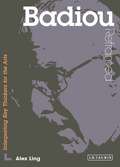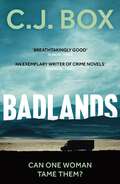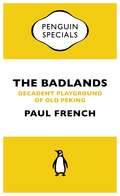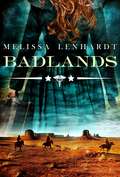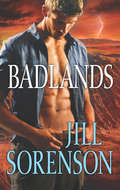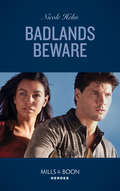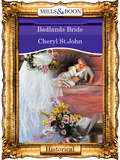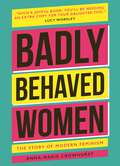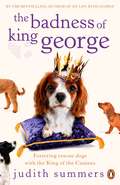- Table View
- List View
Badiou Reframed: Interpreting Key Thinkers for the Arts
by Alex LingHe has been regarded with suspicion by some, as an anti-postmodernist who dared to write about unfashionable concepts such as truth and meaning. But in recent years, the philosopher Alain Badiou has risen in prominence, pioneering new ways to produce, conceptualise and discover art. Badiou Reframed is an original book about an original thinker which applies - for the first time - Badiou's philosophy to the visual arts. The six central concepts of this philosophy - 'being and appearing', 'event and subject' and 'truth and ethics' - are elucidated through detailed analysis of a range of visual artworks, including Marcel Duchamp's readymades, the abstract paintings of Kazimir Malevich and Mark Rothko, Banksy's contemporary street art, the sculpture of Alberto Giacometti, Stephane Mallarme's visual poetry and Victor Fleming's classic film The Wizard of Oz. In focusing on Badiou's critical relationship with the visual arts, Alex Ling reinterprets and represents not only the man, but art itself.
Badiou Reframed: Interpreting Key Thinkers for the Arts (Contemporary Thinkers Reframed)
by Alex LingHe has been regarded with suspicion by some, as an anti-postmodernist who dared to write about unfashionable concepts such as truth and meaning. But in recent years, the philosopher Alain Badiou has risen in prominence, pioneering new ways to produce, conceptualise and discover art. Badiou Reframed is an original book about an original thinker which applies – for the first time – Badiou's philosophy to the visual arts. The six central concepts of this philosophy – 'being and appearing', 'event and subject' and 'truth and ethics' – are elucidated through detailed analysis of a range of visual artworks, including Marcel Duchamp's readymades, the abstract paintings of Kazimir Malevich and Mark Rothko, Banksy's contemporary street art, the sculpture of Alberto Giacometti, Stéphane Mallarmé's visual poetry and Victor Fleming's classic film The Wizard of Oz. In focusing on Badiou's critical relationship with the visual arts, Alex Ling reinterprets and represents not only the man, but art itself.
Badiou's 'Being and Event': A Reader's Guide (Reader's Guides)
by Christopher NorrisAlain Badiou's Being and Event is the most original and significant work of French philosophy to have appeared in recent decades. It is the magnum opus of a thinker who is widely considered to have re-shaped the character and set new terms for the future development of philosophy in France and elsewhere. This book has been written very much with a view to clarifying Badiou's complex and demanding work for non-specialist readers. It offers guidance on philosophical and intellectual context, key themes, reading the text, reception and influence; and further reading.
Badiou's 'Being and Event': A Reader's Guide (Reader's Guides)
by Christopher NorrisAlain Badiou's Being and Event is the most original and significant work of French philosophy to have appeared in recent decades. It is the magnum opus of a thinker who is widely considered to have re-shaped the character and set new terms for the future development of philosophy in France and elsewhere. This book has been written very much with a view to clarifying Badiou's complex and demanding work for non-specialist readers. It offers guidance on philosophical and intellectual context, key themes, reading the text, reception and influence; and further reading.
Badiou's Being and Event and the Mathematics of Set Theory
by Burhanuddin BakiAlain Badiou's Being and Event continues to impact philosophical investigations into the question of Being. By exploring the central role set theory plays in this influential work, Burhanuddin Baki presents the first extended study of Badiou's use of mathematics in Being and Event. Adopting a clear, straightforward approach, Baki gathers together and explains the technical details of the relevant high-level mathematics in Being and Event. He examines Badiou's philosophical framework in close detail, showing exactly how it is 'conditioned' by the technical mathematics. Clarifying the relevant details of Badiou's mathematics, Baki looks at the four core topics Badiou employs from set theory: the formal axiomatic system of ZFC; cardinal and ordinal numbers; Kurt Gödel's concept of constructability; and Cohen's technique of forcing. Baki then rebuilds Badiou's philosophical meditations in relation to their conditioning by the mathematics, paying particular attention to Cohen's forcing, which informs Badiou's analysis of the event. Providing valuable insights into Badiou's philosophy of mathematics, Badiou's Being and Event and the Mathematics of Set Theory offers an excellent commentary and a new reading of Badiou's most complex and important work.
Badiou's Being and Event and the Mathematics of Set Theory
by Burhanuddin BakiAlain Badiou's Being and Event continues to impact philosophical investigations into the question of Being. By exploring the central role set theory plays in this influential work, Burhanuddin Baki presents the first extended study of Badiou's use of mathematics in Being and Event. Adopting a clear, straightforward approach, Baki gathers together and explains the technical details of the relevant high-level mathematics in Being and Event. He examines Badiou's philosophical framework in close detail, showing exactly how it is 'conditioned' by the technical mathematics. Clarifying the relevant details of Badiou's mathematics, Baki looks at the four core topics Badiou employs from set theory: the formal axiomatic system of ZFC; cardinal and ordinal numbers; Kurt Gödel's concept of constructability; and Cohen's technique of forcing. Baki then rebuilds Badiou's philosophical meditations in relation to their conditioning by the mathematics, paying particular attention to Cohen's forcing, which informs Badiou's analysis of the event. Providing valuable insights into Badiou's philosophy of mathematics, Badiou's Being and Event and the Mathematics of Set Theory offers an excellent commentary and a new reading of Badiou's most complex and important work.
Badiou's Deleuze
by Jon RoffeBadiou's Deleuze presents the first thorough analysis of one of the most significant encounters in contemporary thought: Alain Badiou's summary interpretation and rejection of the philosophy of Gilles Deleuze. Badiou's reading of Deleuze is largely laid out in his provocative book, Deleuze: The Clamor of Being, a highly influential work of considerable power. Badiou's Deleuze presents a detailed examination of Badiou's reading and argues that, whilst it fails to do justice to the Deleuzean project, it invites us to reconsider what Deleuze's philosophy amounts to, to reassess Deleuze's power to address the ultimate concerns of philosophy. Badiou's Deleuze analyses the differing metaphysics of two of the most influential of recent continental philosophers, whose divergent views have helped to shape much contemporary thought.
Badiou's Deleuze
by Jon RoffeBadiou's Deleuze presents the first thorough analysis of one of the most significant encounters in contemporary thought: Alain Badiou's summary interpretation and rejection of the philosophy of Gilles Deleuze. Badiou's reading of Deleuze is largely laid out in his provocative book, Deleuze: The Clamor of Being, a highly influential work of considerable power. Badiou's Deleuze presents a detailed examination of Badiou's reading and argues that, whilst it fails to do justice to the Deleuzean project, it invites us to reconsider what Deleuze's philosophy amounts to, to reassess Deleuze's power to address the ultimate concerns of philosophy. Badiou's Deleuze analyses the differing metaphysics of two of the most influential of recent continental philosophers, whose divergent views have helped to shape much contemporary thought.
Badlands (Cassie Dewell #2)
by C.J. BoxInvestigator Cassie Dewell is thrust into the middle of a gang war in the crime series that inspired Big Sky.Can one woman tame them?30º below zero, but Grimstad – like hell – hasn't frozen over. The middle-of-nowhere town has struck oil. As oil flows out, men and money flow in. And with them comes organized crime.Cassie Dewell, Grimstad's newly appointed deputy sheriff, has been thrust into the middle of a brutal gang war that's leaving bodies scattered across town.Cassie knows she's in over her head. But one witness keeps turning up at her crime scenes: a 12-year-old boy with a knack for being in the wrong place at the wrong time.And he might just be the key to her survival.
The Badlands: Decadent Playground of Old Peking (Penguin Specials)
by Paul FrenchThe Badlands by Paul French - a gripping criminal portrait of pre-communist Peking, from the interntional bestselling author of Midnight in PekingThe Badlands, a warren of narrow hutongs in the eastern district of pre-communist Peking, had its heyday in the 1930s. Home to the city's drifters, misfits and the odd bohemian, it was a place of opium dens, divebars, brothels, flophouses and cabarets, and was infamous for its ability to satisfy every human desire from the exotically entertaining to the criminally depraved. These vignettes of eight non-Chinese residents of the precinct White Russians, Americans and Europeans bring the Badlands vividly back to life, providing a short but potent account of a place and a way of life until now largely forgotten, but here rendered unforgettable.Praise for Midnight in Peking:'An instant true crime classic. Grips from the first page to the last' David Peace, author of Red Riding and The Damned United'Fascinating and irresistible. I couldn't put it down' John Berendt, author of Midnight in the Garden of Good and Evil'Written in the style of a gripping murder mystery, but all the facts are true' Kirsty Lang, BBC Radio 4 (Book of the Week)'Engrossing true crime whodunnit... A terrific read' Andrew Holgate, Sunday TimesBorn in London, Paul French has lived in China for more than 10 years. He is a widely published analyst and commentator on China; his books include a history of North Korea, a biography of Shanghai adman and adventurer Carl Crow, and a history of foreign correspondents in China.
Badlands (Sawbones #3)
by Melissa LenhardtOutlander meets post-Civil War unrest in the conclusion to Melissa Lenhardt's fast-paced historical series."A fast-paced page-turner, kill or be killed historical romance with bandits, Pinkerton agents, bounty hunters, mystery and more. Melissa Lenhardt writes with passion and does not hold anything back. Her research on the historical facts and people she portrays enhances the plot without overwhelming." -- RT Book Reviews (4.5 stars, Top Pick!) on Blood OathLaura's worst fears have been realized: Kindle has been taken into custody and she is once again on the run. The noose awaits her in New York, but Laura is realizing that there are some things worse than death. Finally running out of places to hide, it may be time for Dr. Catherine Bennett to face her past. "Packs a big punch with grit and raw passion. There is mystery, murder, Indians, bounty hunters and intrigue. The women are brave, intelligent and don't take crap from anyone. Lenhardt is a talented, creative writer; she has a grand slam out of the park with Sawbones." -- RT Book Reviews (Top Pick!) 4.5 stars"Raw, gritty and sometimes graphic, Melissa Lenhardt has crafted a page-turner. In Sawbones, the women are smart, brave and at times 'incorrigible.' The plot twists, unique characters and intriguing story of passion and betrayal make this a book well worth discovering." -- Jane Kirkpatrick, New York Times bestselling author of A Light in the Wilderness"Absolutely loved it! I couldn't tear myself away from Sawbones. An epic story of love and courage that sweeps from east to west, Sawbones will rip right through you." -- Marci Jefferson, author of Girl on the Golden Coin"You will fall in love with Catherine, as I did, as she struggles to assert herself in a violent and treacherous world, fighting not only prejudice but evil." -- Sandra Dallas, New York Times bestselling author"Sawbones is a thoroughly original, smart and satisfying hybrid, perhaps a new subgenre: the feminist Western." -- Lone Star Literary LifeLaura Elliston novelsSawbonesBlood Oath Badlands
Badlands Beware: Chain Of Custody (holding The Line) / Badlands Beware (a Badlands Cops Novel) (A Badlands Cops Novel #5)
by Nicole HelmThe truth might hurt them both.
Badlands Bride (Mills And Boon Vintage 90s Modern Ser.)
by Cheryl St.JohnShooting a bandit was reporter Hallie Wainwright's introduction to the Wild West, where she'd traveled with a bevy of mail-order brides.
The Badlands of Modernity: Heterotopia and Social Ordering (International Library of Sociology)
by Kevin HetheringtonThe Badlands of Modernity offers a wide ranging and original interpretation of modernity as it emerged during the eighteenth century through an analysis of some of the most important social spaces. Drawing on Foucault's analysis of heterotopia, or spaces of alternate ordering, the book argues that modernity originates through an interplay between ideas of utopia and heterotopia and heterotopic spatial practice. The Palais Royal during the French Revolution, the masonic lodge and in its relationship to civil society and the public sphere and the early factories of the Industrial Revolution are all seen as heterotopia in which modern social ordering is developed. Rather than seeing modernity as being defined by a social order, the book argues that we need to take account of the processes and the ambiguous spaces in which they emerge, if we are to understand the character of modern societies. The book uses these historical examples to analyse contemporary questions about modernity and postmodernity, the character of social order and the significance of marginal space in relation to issues of order, transgression and resistance. It will be important reading for sociologists, geographers and social historians as well as anyone who has an interest in modern societies.
The Badlands of Modernity: Heterotopia and Social Ordering (International Library of Sociology)
by Kevin HetheringtonThe Badlands of Modernity offers a wide ranging and original interpretation of modernity as it emerged during the eighteenth century through an analysis of some of the most important social spaces. Drawing on Foucault's analysis of heterotopia, or spaces of alternate ordering, the book argues that modernity originates through an interplay between ideas of utopia and heterotopia and heterotopic spatial practice. The Palais Royal during the French Revolution, the masonic lodge and in its relationship to civil society and the public sphere and the early factories of the Industrial Revolution are all seen as heterotopia in which modern social ordering is developed. Rather than seeing modernity as being defined by a social order, the book argues that we need to take account of the processes and the ambiguous spaces in which they emerge, if we are to understand the character of modern societies. The book uses these historical examples to analyse contemporary questions about modernity and postmodernity, the character of social order and the significance of marginal space in relation to issues of order, transgression and resistance. It will be important reading for sociologists, geographers and social historians as well as anyone who has an interest in modern societies.
Badlands of the Republic: Space, Politics and Urban Policy (RGS-IBG Book Series #78)
by Mustafa DikecThe relationship between space and politics is explored through a study of French urban policy. Drawing upon the political thought of Jacques Rancière, this book proposes a new agenda for analyses of urban policy, and provides the first comprehensive account of French urban policy in English. Essential resource for contextualizing and understanding the revolts occurring in the French ‘badland’ neighbourhoods in autumn 2005 Challenges overarching generalizations about urban policy and contributes new research data to the wider body of urban policy literature Identifies a strong urban and spatial dimension within the shift towards more nationalistic and authoritarian policy governing French citizenship and immigration
Badlands of the Republic: Space, Politics and Urban Policy (RGS-IBG Book Series)
by Mustafa DikecThe relationship between space and politics is explored through a study of French urban policy. Drawing upon the political thought of Jacques Rancière, this book proposes a new agenda for analyses of urban policy, and provides the first comprehensive account of French urban policy in English. Essential resource for contextualizing and understanding the revolts occurring in the French ‘badland’ neighbourhoods in autumn 2005 Challenges overarching generalizations about urban policy and contributes new research data to the wider body of urban policy literature Identifies a strong urban and spatial dimension within the shift towards more nationalistic and authoritarian policy governing French citizenship and immigration
The Badly Behaved Bible: Thinking again about the story of Scripture
by Nick PageWe're told that the Bible is beautiful, uplifting and a joy to read - but, while we know this is how we're supposed to feel about it, in reality many of us find the very opposite. On opening the Bible, we are faced with a multitude of problems; from its form and historical content to its sheer size and often distasteful stories, we can be left feeling overwhelmed and disheartened. But the problem is not with the Bible - and it's not with us either.The problem is we've been misinformed. And so, we end up believing things about the Bible that the Bible never claims for itself. But the Bible won't politely sign up to the neat categories and terms we force on it. That's why it's badly behaved. We want to control the Bible and tame it so that we can ride it into battle; but the Bible bucks and rears and throws us off. We want to pin the Bible down so that it proves our theology; but the Bible evades capture and plays hide and seek. We want answers; but the Bible keeps firing questions. We want it to tell us what to do; but the Bible keeps telling us to think. We want to make the Bible dance to our tune: but the Bible has music of its own. The Bible is an invitation and a call. The breath of God lifts its pages, and they rise and fall with his breathing.In his honest and accessible style, Nick Page urges us to re-discover a fresh look at the Bible as thescriptural bedrock of the Christian faith, to learn how we can undo unhelpful ways of reading it anddemystifying its purpose and scope.Nick tackles what the Bible is and what it isn't, how we can critically read this inspired text and how we approach the difficulties in its content.Alongside helpful analysis and practical advice - including kickstarting his one-man campaign to ban"Bible study" - Nick helps us re-discover how to rediscover the Bible as Holy Ground, as a place where we meet and encounter God.
Badly Behaved Women: The History of Modern Feminism
by Anna-Marie CrowhurstFrom bra burning and body hair to Beyoncé and body positivity, feminism has come a long way.The illustrated story of the women's movement, Badly Behaved Women is a compelling and entertaining journey through the four waves of feminism and beyond. Featuring rare photographs and paraphernalia, reading lists, playlists and timelines, Anna-Marie Crowhurst's new history of an ongoing battle captures the pop culture and politics that have shaped modern feminism, and where the fight for equal rights will take us next.Personal testimony essays from: Alice Coffin; Juno Dawson; Diana Evans; Nadia Ghulam; Susie Orbach; Helen Pankhurst; Gisela Pérez de Acha; Laura Perlongo; Emeli Sandé; Anne Wafula Strike; Hibo Wardere; Harriet Wistrich; Rosie Wolfenden.
Badminton Horse Trials at 75
by Kate GreenIn 1949, the 10th Duke of Beaufort started Badminton Horse Trials with the idea of better preparing British riders for the Olympic Games after a disastrous showing on home ground the year before. His legacy is the world's oldest and most prestigious horse trials, which has captured the imagination of riders worldwide and in 2024 celebrates its seventy-fifth anniversary. Badminton is still an Olympic proving ground as well as a captivating place where dreams can be made or shattered, and the one all riders want to win. The centrepiece remains the cross-country course, a spectacle that draws thousands of spectators and is an imposing challenge for riders, no matter how experienced they are, in an egalitarian sport in which men and women compete on equal terms and the amateur can take on the Olympic gold medallist. This superbly illustrated book celebrates those riders and their horses, from Sheila Willcox's hattrick in the 1950s to New Zealander Mark Todd who came out of retirement to win three decades after his first victory; from the golden era of Richard Meade, Captain Mark Phillips, Lucinda Green and Princess Anne, to twenty-first-century heroes and heroines, including William Fox-Pitt, Pippa Funnell, Andrew Nicholson, Michael Jung, Oliver Townend and Rosalind Canter.
Badminton (Large Print)
by Rnib BookshareThis page shows a diagram of a badminton court, a badminton racquet, a player about to hit a shuttlecock, and a shuttlecock. Each image has a dashed line image border. There is a locator dot shown, which will be at the top left of the page when the image is the right way up. Diagram of a badminton court (left) This diagram has one end of the court at the top of the page and one end at the bottom. The end at the top shows the markings for singles play bordered by a heavy dashed (red on Large Print) line. The textured (light green on Large Print) area shows the area for serving. The horizontal dashed (red on Large Print) line at the top of this area is the long service line for singles play and down from this is the long service line for doubles. Further down are the short service line and the net with large dots showing the position of the net posts. The area down the page from the net shows the layout for doubles play bordered by a heavy dashed (yellow on Large Print) line. Further down is the short service line, the serving area, the long service line for doubles, and the long service area for singles. Badminton racquet (top centre) This is an image of a badminton racquet seen from the front. The oval head of the racquet is on the left of the image with the strings stretched across it vertically and horizontally. To the right is the shaft and handle of the racquet. Badminton player (bottom centre) This is an image of a badminton player about to hit a shuttlecock. He is seen from the side and facing to the left. In the top right of the image the player holds his racquet and to the left is a shuttlecock in mid-air. Down and to the left is the arm of the player leading to his body, his other arm extending to the left and his head up the page. Further down are his legs and feet with the floor at the bottom of the image. He is wearing a singlet and shorts. Shuttlecock (bottom right) This is an image of a shuttlecock seen from the side. At the top of the image are the feathers in an open cone arrangement (there are sixteen but only five have been shown, for clarity). Further down are two horizontal lines of string, tying them together. At the bottom of the image is the cork, which is covered in leather with the shafts (quills) of the feathers glued into it.
Badminton (UEB Contracted)
by Rnib BookshareThis page shows a diagram of a badminton court, a badminton racquet, a player about to hit a shuttlecock, and a shuttlecock. Each image has a dashed line image border. There is a locator dot shown, which will be at the top left of the page when the image is the right way up. Diagram of a badminton court (left) This diagram has one end of the court at the top of the page and one end at the bottom. The end at the top shows the markings for singles play bordered by a heavy dashed (red on Large Print) line. The textured (light green on Large Print) area shows the area for serving. The horizontal dashed (red on Large Print) line at the top of this area is the long service line for singles play and down from this is the long service line for doubles. Further down are the short service line and the net with large dots showing the position of the net posts. The area down the page from the net shows the layout for doubles play bordered by a heavy dashed (yellow on Large Print) line. Further down is the short service line, the serving area, the long service line for doubles, and the long service area for singles. Badminton racquet (top centre) This is an image of a badminton racquet seen from the front. The oval head of the racquet is on the left of the image with the strings stretched across it vertically and horizontally. To the right is the shaft and handle of the racquet. Badminton player (bottom centre) This is an image of a badminton player about to hit a shuttlecock. He is seen from the side and facing to the left. In the top right of the image the player holds his racquet and to the left is a shuttlecock in mid-air. Down and to the left is the arm of the player leading to his body, his other arm extending to the left and his head up the page. Further down are his legs and feet with the floor at the bottom of the image. He is wearing a singlet and shorts. Shuttlecock (bottom right) This is an image of a shuttlecock seen from the side. At the top of the image are the feathers in an open cone arrangement (there are sixteen but only five have been shown, for clarity). Further down are two horizontal lines of string, tying them together. At the bottom of the image is the cork, which is covered in leather with the shafts (quills) of the feathers glued into it.
Badminton (UEB Uncontracted)
by Rnib BookshareThis page shows a diagram of a badminton court, a badminton racquet, a player about to hit a shuttlecock, and a shuttlecock. Each image has a dashed line image border. There is a locator dot shown, which will be at the top left of the page when the image is the right way up. Diagram of a badminton court (left) This diagram has one end of the court at the top of the page and one end at the bottom. The end at the top shows the markings for singles play bordered by a heavy dashed (red on Large Print) line. The textured (light green on Large Print) area shows the area for serving. The horizontal dashed (red on Large Print) line at the top of this area is the long service line for singles play and down from this is the long service line for doubles. Further down are the short service line and the net with large dots showing the position of the net posts. The area down the page from the net shows the layout for doubles play bordered by a heavy dashed (yellow on Large Print) line. Further down is the short service line, the serving area, the long service line for doubles, and the long service area for singles. Badminton racquet (top centre) This is an image of a badminton racquet seen from the front. The oval head of the racquet is on the left of the image with the strings stretched across it vertically and horizontally. To the right is the shaft and handle of the racquet. Badminton player (bottom centre) This is an image of a badminton player about to hit a shuttlecock. He is seen from the side and facing to the left. In the top right of the image the player holds his racquet and to the left is a shuttlecock in mid-air. Down and to the left is the arm of the player leading to his body, his other arm extending to the left and his head up the page. Further down are his legs and feet with the floor at the bottom of the image. He is wearing a singlet and shorts. Shuttlecock (bottom right) This is an image of a shuttlecock seen from the side. At the top of the image are the feathers in an open cone arrangement (there are sixteen but only five have been shown, for clarity). Further down are two horizontal lines of string, tying them together. At the bottom of the image is the cork, which is covered in leather with the shafts (quills) of the feathers glued into it.
The Badness of King George
by Judith SummersJudith Summers' life is about to change dramatically.Her five-year relationship with her on-off boyfriend has finally ended. Her son, Joshua, is off to university, and for the first time since her husband died she's living alone. Well, not entirely alone. She still has George, her King Charles Spaniel. Judith knows she needs a new challenge. But how free can she ever be with George in tow? He is, of course, immensely lovely. But he's also spoilt, lazy, and prone to flouncing around the house like a fluffed-up diva.But then, during a chance encounter , Judith finds out about Many Tears, a dog rescue centre. Before she knows it, she has joined a nationwide network of canine foster carers. Far from having Judith all to himself, George suddenly finds he has to share his owner with lots of other less fortunate dogs. And he's finding adjusting to this new way of life a bit of a challenge...
